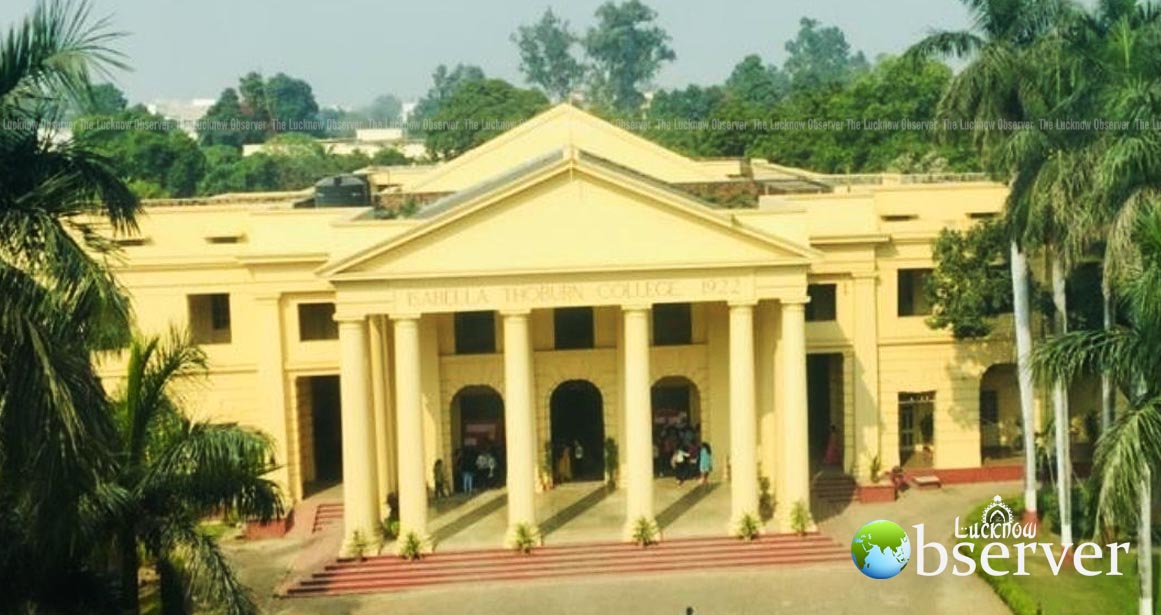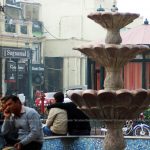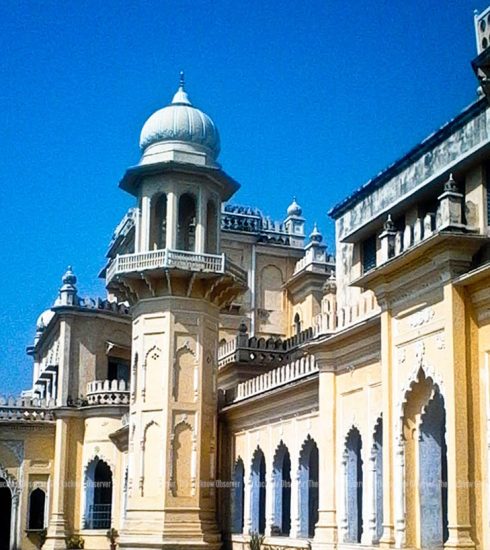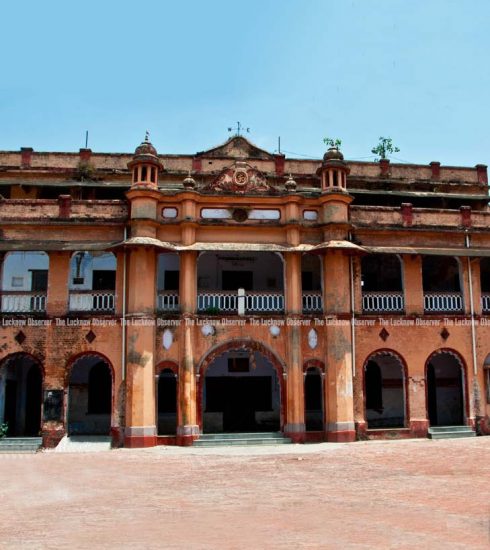IT College
Epitome of Girl’s Education
Known as a landmark aid to the city’s navigational needs, IT Chauraha is home to a treasure of notable repute to which it owes its effective coinage. Enclosed within tall beige boundaries lies concealed the momentous edifice of Isabella Thoburn College, quietly asserting its proud and stately bearing.
A mere “wilderness beyond the University” at the time of its conception in 1922, it has become a respectable centre of education for girls.
Every thread of Isabella Thoburn College’s illustrious past has an inimitable and compelling story but none as great as the paramount legend of its founder’s unassailable courage and determination that led to its birth. Miss Isabella Thoburn of the women’s foreign missionary society of Boston sailed to India in 1869 with a dream to provide a sound Christian education to the women of India at a time when the purgatory purdah prevailed and a scheme to elevate them thus seemed an ill-founded fantasy.
However, if the obstacles persisted, so did Isabella Thoburn’s iron will. Unable to secure proper grounds for a school, the milestone journey began in a small room amidst the crowd and din of the streets of Aminabad on 18th April 1870, with only six students, and a dutiful brother standing guard. Thereon the institution launched upon a gradual but promising path of evolution.
Within a year, it became Christian Girls’ Boarding School, graduating to Lal Bagh as Lucknow Women’s College on July 12, 1886 with a humanities wing affiliated to Calcutta University and Allahabad University subsequently. After Miss Thoburn’s death in 1901, the college was renamed Isabella Thoburn College to pay homage to her celestial being and it was in 1922 that the present premises on erstwhile Chandbagh grounds were founded with Isabella Thoburn school in tow for higher classes.
Today the college extends learning to over 3500 pupils, inviting aspirants from across the state and farther and providing education in all major streams at undergraduate and postgraduate levels. Its humanities wing remains its most seasoned offering being the first stalwart of the cause, commerce the most recent addition. Biotechnology, women studies, education, library science and nutrition remain some of its elite specialities, churning out efficient professionals with each passing batch.
Health, honesty, courtesy, poise, dependability, spirituality, scholarliness, loyalty, broad-mindedness and service are the ten pillars of the institute’s impregnable and enduring ideology, reinstated to the newcomers with fervour in ‘portal ceremony’. Tradition is the underlying current, the steady hand that keeps the mechanism robust and spirited, infected with an old world charm, infused with the inflow of newer ideas and energies. Friday prayer assemblies, worship service in the chapel, youngsters of the casual college strain would imagine a burden, but as the principal Dr Vinita Prakash related memorably in one of the assemblies, the former students whom she came across remembered the services and various traditions as fondly as any moments of fun with friends.
Spiritual and moral value education (SVE) class conducted on Thursdays has been an uplifting tradition for students for years, where matters pertaining to religion, spiritual being, morals, conduct, and the status of women in society are analysed. The college magazine, Chandbagh Chronicle, in itself an arduous and laudable institution ,carried out by the literary intellects that have graced the portals of IT , records how these SVE classes for many were a channel of development and growth.
Arbour day observed each year to mark the importance of conserving nature, sees participants dressed in ritual green, planting trees, a gauge of the accountability imbued in the ITian soul, devised and exercised much earlier than its present equivalent of environment day. The glorious tale of Miss Thoburn’s conquest is recounted each year at the founder’s day with grateful alumni recalling their journey through her blessed haven. Baccalaureate day for the meritorious, karamchari divas for its loyal caretakers, the golden circle marking a passage of rites from outgoing students to the continuing, are all inextricable parts of the unique culture fostered in the confines of it college. Christmas celebrations, the decorating of hostel drawing rooms in competition, the choir in white and red ensemble mesmerizing with melodious hymns in the cantata (host to the chief minister this year) keep the students joyfully engaged. The college fest Rangmanch, other departmental activities give vent to the hordes of talents contained here. Sports day sees participation by the four houses, Nichols, Razia, Laxmi Bai and Sarojini as well as the ever-energetic faculty.
Another repository of tender recollections and fleeting fame is college day, when a drama, Hindi and English alternatively is put up each year in the complete spirt and embodiment of a professional theatre performance. Many proud actors are scattered along the alumni annals for having acted the entertainer’s part. Dr. Ruth Chakravarty, the beloved English teacher and proficient director of the English drama each year for more than past thirty years, has captivated the hearts of her students and made many a passionate devotees of English literature out of young, adrift souls. Her admirers are scattered as far and wide as is the scope of the essential Thoburn circle (quite vast and intercontinental, frankly). Dr. Mala Singh, an alumna of the college, now the principal of a reputed city school recalls “after the initial bunking episodes I found myself inspired deeply by Mrs. Ruth Chakravarty and Ms. Puja Juyal, my English and Political Science lecturers. English Literature had become my favourite subject and there was this constant feeling to impress the Teacher. This desire to be one up on the rest of the class to gain the favour of the teacher led me to be the first one to seek out the priceless reference books in the Library, to burn the midnight oil to impress upon Mam Chakravarty; the intent to excel within had soon become a way of life.” Dr. Chakravarty interestingly, herself a proud product of this very institution who gladly states, once introduced to the charms and beauty of this place and the tremendous wealth of discoveries, of knowledge, of love, of values, it was impossible to break away and be at any place other than this. And so she has continued the bond, cultivating the core that once nurtured her with ardent devotion, intellect and care.
Many such diligent associations are found in the corridors of the college. the entire faculty is interspersed with honourable names, Dr Solomon, Dr Shaw, Dr Harrison, Dr Juyal; Dr Bhatia spiritedly exclaims as to the reason behind her occupation “I love teaching and being surrounded by youngsters, full of energy”; all exemplary teachers and guides, riveting role models. The patent and proud reason behind the illustrious alumni the institution boasts of. Often the sprightly spirit of the faculty supersedes their young pupils, and one never fails to marvel at their enthusiasm.
Traversing the broad and luminous prospects of Isabella Thoburn College is truly traversing a dream. Not the metaphorical one, but a palpable, living and prospering dream; That of Miss Thoburn of educating young girls to be respectable and accountable individuals. It is this infectious, compelling trace of that power, of that passion and zeal that brought a woman sailing over wide seas to distant lands, that has touched its prodigious progeny and elevated them with its overwhelming ferocity and inspiration. The literary geniuses of Atia Hosain, Qurratulain Haider, Ismat Chugtai once inhabited these very stations. Padmashri Dr Mohini Giri, first chairperson of National Commission for Women in India; three of the five members of the first committee of National Commission for Women were ITians; the first woman IAS officer, Isha B. Joshi, actress Bina Rai, are some of the gems shining on its gleaming crown, though its radiance has spread further and the jewels are too many to be named. Lucknawi households unfailingly manage to find a linking thread to the college, a gracious aunt, a loving mother, a successful associate, an inspiring teacher , all have a home in it.
The firm founding ground for these formed through little endeavours, leading to great results. The college student bodies, Students’ Government Association (SGA) and Student Christian movement (SCM) imbibe leadership skills; several social welfare committees have been functional in the college. the service learning programme under which come the beneficial centre for education beyond curriculum (CEDBEC), aids awareness centre (AACCET), nutritional initiatives for community (NICHE), adult continuing education and extension unit, Night school to promote literacy, Sunday school for the underprivileged, CWSD, centre for women’s studies all induce growth and change in the society around them providing the students with opportunities to learn about their environment and assume responsibility. The NSS and NCC units have been consistent servitors. Their impact is visible in the immediate community of the college. The slums in Nishatganj, hutments in Nirala Nagar and Daliganj, projects of NSS and other endeavours have benefited from their efforts. Mrs. Neelam Kumari, Home Science teacher and a leader of the NICHE initiative informed the students during a social accountability workshop ,“There was a time when these communities would not let us near them. For ten years we have visited them. Now at least they participate in our activities, listen to our message and the result is though only slight but a definite improvement and we hope for better in the future”. The NSS wings regularly teach and carry out cleanliness drives in the slums.
Mrs Virginia Singh’s experience (an alumnus of the college, from 1946-53) of the college’s dedication to such matters, as in charge of social service is remarkable. she found the Daliganj Methodist church crumbling and went for aid to then principal Mrs. Sarah Chacko and together with the affirmation of the community they prevented it from demolition and restored it to dignity, so that it stood a smiling milestone. all in keeping with the ever presiding motto of the college “We receive to give”.
It is not a surprise then that the college principal Dr Vinita Prakash pipes in ambitious and progressive prospects for it, “our goal is to educate, enlighten and empower the girls so they achieve for themselves the proud distinction of belonging to this prestigious college. We aim to give them wings as well as roots; rooted to tradition and humility and wings to soar high in the realms of success; become accountable citizens and dignified individuals”. The energy and ease of the head gives a democratic air to the whole administration and institution.
The Sarah Chacko memorial library (after the late principal), a keeper of precious relics contained in dusty pages amidst crawling silver fish; the names of previous seekers a pleasant nudge from the past to proceed with a grateful smile. Many a bibliophiles and many a thankful converts have submitted to the intellectual sway of this monument, its warm and inviting hues (meaning ancient and fragile precious antiques alternated with bursts of newer talents and intrigues). the creepers ,flushed blossoms , the enlightening view of the chapel from the first floor; anticipation contained in shelves, all add to the experience that is this library. The latest addition, the bright and beaming American corner with its volumes of novel editions, shining crisp and new, looking like excited bubbly broods amidst stern, wise grandfather specimens is a perpetually tempting impetus to dive in this sagacious treasure. and ruling the kingdom of erudition with perfect dexterity and poise, a characteristic conspiring tone and jocularity and concern alternating with simulations of severity (unintelligible to the uninitiated and thus restricted to a privileged group) is the librarian, Mr Satwant. He was so desolate at retiring from his passion for years, that he wept through the night after his farewell, returning the next morning to his rightful throne. Forever helpful, forever complying with the young readers’ bizarre hints as to their bookish needs, he has been an allaying constant of the ITian soul. Blessing the regulars with prized treasures and a generous “get a first division”, one knows it is a kingdom that expects excellence and no less. His presence is an integral part of the library and it is with good reason the former students of the college remember him with great love and fondness.
The very architecture of the college inspires poetry. Besides the perfunctory, state of the art labs, grounds, a much used sunny quadrangle, and the most frequented haunt, the canteen with its famous ‘chunchun rolls’, nescafe shed, the beauty of the buildings is incredible. it seems the portals, the well-kept and the wild creepers, the lotuses floating in tiny ponds, or the palm arching the chapel speak in a different language to the sincere adherent. They soothe the soul and the beauty of their songs remains with the listener for life, appeasing and assuaging when nothing else is. Who other than a thouburnian truant would know the beauty of the rain washed campus, the wonderful peacoks found lurking in the aftermath or the tranquillity of the campus in the late noon made musical by the choir practises.
The inhabitants of the three hostels, Maitrei Bhawan, Naunihal Manzil and Nishat Mahal and that of the teachers’ kothi are fortunate beings all would agree for it is from these the best memories arise- the chronicle abounds with the raptures of alumni. precious times of youth, outings, bunking classes, escaping assemblies, hiding from the patrolling SGA in the disused swimming pool, or lectures held in the ‘Harcourt Butler’ room, with the huge picture windows offering beautiful vistas of the leaning hibiscus on one side and the huge sheltering ancient shade of the ever flourishing banyan on the other and, before you the enticing realms of literature (or the wry graphs of economics) as was the wont. the Doric pillars, the American colonial design and feel, the beautiful carved façade of the chapel; rows of eucalyptus trees once made for long walks, now it is not so woody anymore, subsiding gently to let learning take root. But its little faithful landmarks still stay with the occupants, the purple blossoms of the crepe myrtle near the chapel against the azure of the sky, the fragrant orchid peeping into the windows of the psychology lab. Then the assiduity of the scrupulous gardener supplying the landscape with perfect splashes of colours, dahlias, hollyhocks, poinsettias, poppies, the roses; the saplings quietly announcing new weather rather than anything else.

People recount glamorous and enjoyable tales of balls and gala parties held at the college. Dr Simlai, geography teacher and former student recounted in her foundation day speech “our teachers used to be very protective of us and would let no boy near us “. in spite of the strict and disciplined environs everyone managed to extract their fair measure of fun. Father Carlyle McFarland, present principal of La Martiniere boys, at the beginning of his lecture at an inaugural function of the college’s literary society ‘Parnassus’ memorably told the audience “it is an honour to be legitimately ‘invited’ and welcomed warmly to the premises of Isabella Thoburn college. My last attempt was with my friends as a student during a much-awaited ball. Our feeble attempts at entrance were crushed by the strict warden shouting in a menacing tone “boys, out!” And we promptly filed our disgraceful retreat. so it is an immense privilege to be respectfully received” to bursts of laughter. Such were the impressions of IT’s enigma on the earlier generation’s psyche.
The fun and enjoyment continues and so does the learning but as with everything else the magic of those “old times” is irreplaceable. The inter college fest AURA was revived successfully this year by the efforts of the SGA, fashioning an unprecedented miracle. The SGA president Sadaf Ayub, a perfect instance of the ITian model, bright student, enthusiastic leader speaks on her team’s achievement” we knew we had to be bridge between the students and faculty and instead of treading on a traversed path, had to create one where none existed”.
So while retaining its traditions and following the path of Christian ethics in prayers and practises, the college has managed to create a hospitable environment, welcoming change and evolving for the better. In the year 2011 it marked 125 glorious years of its existence with fervour, festivities, a visit from the first lady president of India, Pratibha Patil.
Somewhere in the myriad copies of chronicles preserved in the library lies an entry of a devotee appealing to the readers to contribute to the building of a memorial window for Miss Thoburn in a church, faraway in the land of her birth, in America. Also contained was a prompt positive response, both ends eager to bestow due honour to the memory of a remarkable woman.
Nikita Gupta
Writer is student and her passion is painting
(Published in The Lucknow Observer, Volume 1 Issue 11, Dated 05 February 2015)








